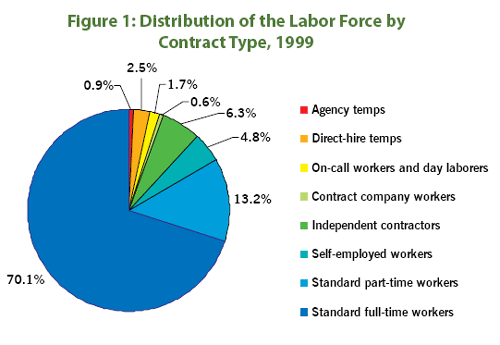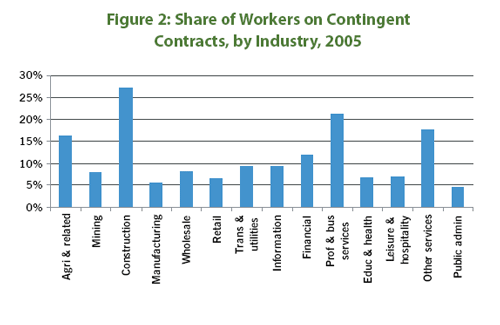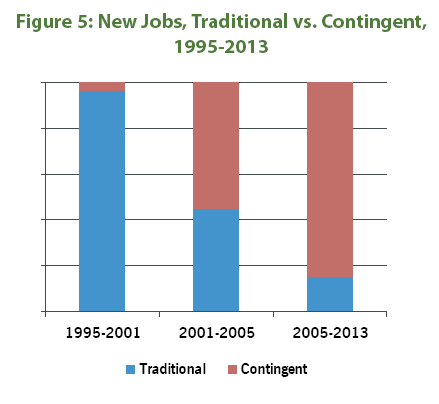Trump's Lump of Coal
The trade deficit is the world’s Christmas gift to the U.S.; Trump’s tariffs substitute a lump of coal.
Growing numbers of Americans no longer hold a regular "job" with a long-term connection to a particular business. Instead, they work "gigs" where they are employed on a particular task or for a defined time, with little more connection to their employer than a consumer has with a particular brand of chips. Borrowed from the music industry, the word "gig" has been applied to all sorts of flexible employment (otherwise referred to as "contingent labor," "temp labor," or the "precariat"). Some have praised the rise of the gig economy for freeing workers from the grip of employers' "internal labor markets," where career advancement is tied to a particular business instead of competitive bidding between employers. Rather than being driven by worker preferences, however, the rise of the gig economy comes from employers' drive to lower costs, especially during business downturns. Gig workers experience greater insecurity than workers in traditional jobs and suffer from lack of access to established systems of social insurance.
How Big Is the Gig Economy? Special surveys by the Bureau of Labor Statistics in 1995, 2001, and 2005, and by the General Accounting Office in 1999, yielded widely varying estimates of the scale of the gig economy. The GAO estimated that as many as 30% of workers were on some type of contingent labor contract, including some categories of workers (self-employed and part-time workers) who are not counted as contingent workers by the BLS. Using the narrower BLS definition, 12% of workers were on contingent contracts in 1999 (similar to the number estimated from more recent surveys). (see Figure 1).

There Are Many Types of Contingent Workers: Contingent workers are employed throughout the economy, in all industries and in virtually all occupations. Using the BLS definition, which includes independent contractors, temporary workers, on-call workers, and workers provided by contract firms, contingent workers made up over 11% of the labor force in 2005. Some contingent workers do low-wage work in agriculture, construction, manufacturing, retail trade, and services; others are employed as highly paid financial analysts, lawyers, accountants, and physicians (see Figue 2).

Adjunct and Part-Time Professors Are Now a Majority of College Faculty: While many people may think of "day laborers" in construction or office "temps" when they think of contingent workers, few occupations have seen as sharp an increase in contingent labor as teaching in higher education. Adjunct and part-time professors now account for the great majority of college faculty nationwide. Tenured and tenure-track faculty now comprise less than a third of the teaching staff, and teach barely half of all classes. Colleges and universities hire adjunct faculty because they make it possible to more precisely match faculty to the demand for classes, and because adjuncts are paid substantially less (see Figure 3).

Why Employers Prefer Contingent Workers: Employers prefer contingent labor because it is more "flexible." Workers can be laid off at any time in response to a decline in sales. Employers can also pay contingent workers less by not offering benefits. By treating many contingent workers as independent contractors, employers avoid paying for government-mandated benefits (the employer's half of Social Security, unemployment insurance, workers' compensation, etc.). They also usually exclude contingent workers from employer-provided benefits such as health insurance and pensions. Counting wages and benefits, contingent workers are paid substantially less than workers in traditional jobs and are left much more vulnerable to illness or economic downturns (see Figure 4).

Most New Jobs Are Contingent: While a solid majority of workers is still employed under traditional arrangements, most new jobs since 2001 have been under contingent arrangements. This is in sharp contrast to the late 1990s, when unemployment rates were low and employers had to offer workers more desirable long-term contracts. With the economic recession of the early 2000s, followed by the Great Recession and the anemic recovery (2007 to the present), however, employers have shunned long-term employment contracts and workers have had to settle (see Figure 5).
